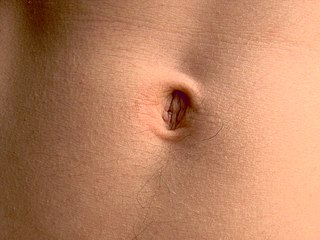
A heteroecious parasite is one that requires at least two hosts. The primary host is the host in which the parasite spends its adult life; the other is the secondary host. Both hosts are required for the parasite to complete its life cycle. This can be contrasted with an autoecious parasite which can complete its life cycle on a single host species. Many rust fungi have heteroecious life cycles:

The navel is a protruding, flat, or hollowed area on the abdomen at the attachment site of the umbilical cord. All placental mammals have a navel, although it is generally more conspicuous in humans.

The Umbilicus Urbis Romae —"Navel of the City of Rome"—was the symbolic centre of the city, a reference point from which, and to which, all distances in Ancient Rome were measured. It was situated in the Roman Forum where its remnants can still be seen. These remains are located beside the Arch of Septimius Severus and the Vulcanal, behind the Rostra. Originally covered in marble, the Umbilicus is now a forlorn-looking brick core some 2 metres high and 4.45 metres in diameter.

Stem rust, also known as cereal rust, black rust, red rust or red dust, is caused by the fungus Puccinia graminis, which causes significant disease in cereal crops. Crop species that are affected by the disease include bread wheat, durum wheat, barley and triticale. These diseases have affected cereal farming throughout history. The annual recurrence of stem rust of wheat in North Indian plains was discovered by K.C. Mehta. Since the 1950s, wheat strains bred to be resistant to stem rust have become available. Fungicides effective against stem rust are available as well.

The umbilicus of a shell is the axially aligned, hollow cone-shaped space within the whorls of a coiled mollusc shell. The term umbilicus is often used in descriptions of gastropod shells, i.e. it is a feature present on the ventral side of many snail shells, including some species of sea snails, land snails, and freshwater snails.

Puccinia hordei is a species of rust fungus. A plant pathogen, it can cause leaf rust of barley, also known as brown rust of barley. It was originally found on the dry leaves of Hordeum vulgare in Germany.

Puccinia pelargonii-zonalis is a fungal species and plant pathogen that causes rust on Pelargonium geraniums. It was originally found on the leaves of Pelargonium zonale in KwaZulu-Natal, South Africa.

Puccinia purpurea is a fungal species and plant pathogen that causes rust on sorghum. It is found in temperate places worldwide, excluding colder parts such as Russia and Canada.
Puccinia subnitens is a fungal species and plant pathogen that causes rust on Beta vulgaris. It was originally found on Distichlis spicata in Montana, USA.

Puccinia recondita is a fungus species and plant pathogen belonging to the order of Pucciniales and family Pucciniaceae.
Puccinia pittieriana is a species of rust fungus. It is a plant pathogen which infects agricultural crops such as potato and tomato. Its common names include common potato rust and common potato and tomato rust.

Puccinia is a genus of fungi. All species in this genus are obligate plant pathogens and are known as rusts. The genus contains about 4000 species.
Prolobitidae is a family of middle and upper Devonian ammonoid cephalopods currently included in the goniatitid suborder Tornoceratina and superfamily Dimeroceratoidea, but previously included in the ancestral Anarcestida.
The Posttornoceratidae are Late Devonian goniatites (Ammonoidea) included in the superfamily Tornoceratoidea. The family, Posttornoceratidae, named by Bogoslovsky in 1962, is based on the genus Posttornoceras, named by Wedekind in 1910, originally included in the Tornoceratidae.

Puccinia malvacearum, also known as hollyhock or mallow rust, is a fungal species within the genus Puccinia known for attacking members of the family Malvaceae. An autoecious pathogen, it can complete its life cycle using a single host.
The genus Cibolaites is a strongly ribbed and nodose ammonoid cephalopod from the middle Cretaceous of western New Mexico, included in the taxonomic family Collignoniceratidae. A single species Cibolaites molenaari is known.
Glyphipterix umbilici is a moth of the family Glyphipterigidae. It is found on the Canary Islands and Sardinia and in Portugal and Lebanon.

Puccinia oxalidis is a fungus species in the genus Puccinia. This species is a causal agent of rust on plants in the genus Oxalis, such as Oxalis articulata. The disease appears as yellow dots on the reverse of the leaves. The aecial stage can also be found on Berberis repens. It was originally found on Oxalis species in Mexico.












